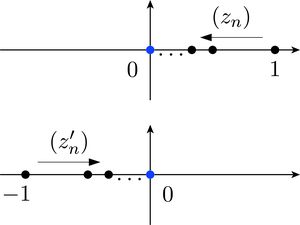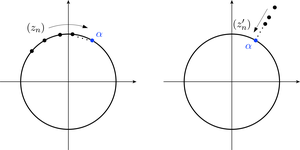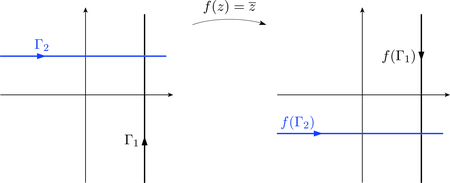1.3 Non-differentiability
In Theorem 1 you saw that differentiability implies continuity. An immediate consequence of this is the following test for non-differentiability.
Strategy A for non-differentiability
If is discontinuous at , then is not differentiable at .
Example 4
Show that there are no points of the negative real axis at which the function is differentiable.
Solution
The function is discontinuous at all points of the negative real axis. It follows that there are no points of the negative real axis at which is differentiable.
Exercise 6
Show that there are no points of the negative real axis at which the principal logarithm function
is differentiable.
Answer
The function Arg is discontinuous at each point of the negative real axis. It follows that Log is discontinuous at each point of the negative real axis, and hence that there are no points on it at which Log is differentiable.
The converse of Theorem 1 is not true; if a function is continuous at a point, then it does not follow that it is differentiable at the point. A particularly striking illustration of this is provided by the modulus function . This is continuous on the whole of and yet, as you will see, it fails to be differentiable at any point of .
Since is continuous, Strategy A cannot be used to show that is not differentiable at a given point . Instead we return to the definition of derivative and show that the difference quotient for fails to have a limit.
In general, if the domain of a function contains as one of its limit points, then the existence of the limit
means that for each sequence in that converges to ,
exists, and has a value that is independent of the sequence .
So, if two such sequences and can be found for which
then cannot be differentiable at .
In the next example, you will see that is not differentiable at . This result should not surprise you because the real modulus function is not differentiable at . Indeed, the proof is identical to that of the real case.
Example 5
Prove that is not differentiable at 0.
Solution
We need to find two sequences and that converge to 0 which, when substituted into the difference quotient, yield sequences with different limits. A simple choice is to pick sequences and that approach 0 along the real axis: one from the right, and one from the left, as shown in Figure 4.
There is no point in picking sequences that are more complicated than they need to be, so let , . Then
Now let , . Then
Since the two limits do not agree, the difference quotient does not have a limit as tends to 0. It follows that is not differentiable at 0.
The next exercise asks you to extend the method used in Example 5 to show that is not differentiable at any point of .
Exercise 7
Let be any non-zero complex number, and consider the circle through centred at the origin. By choosing one sequence that approaches along the circumference of the circle, and another sequence that approaches along the ray from through , prove that is not differentiable at .
Answer
Let , . Then tends to along the circumference of the circle, and
Now let , . Then tends to along the ray from through , and
Since for , these two limits do not agree. It follows that is not differentiable at .
The modulus function illustrates an important difference between real and complex differentiation. When the modulus function is treated as a real function, the limit of its difference quotient has to be taken along the real line. But when treated as a complex function, the limit of the difference quotient is required to exist however the limit is taken. This explains why the real modulus function is differentiable at all non-zero real points, whereas the complex modulus function fails to be differentiable at any point of . More generally, it shows that complex differentiability is a much stronger condition than real differentiability.
In Exercise 7 you were asked to prove that the modulus function fails to be differentiable by observing that its behaviour along the circumference of a circle centred at 0 is different from its behaviour along a ray. Similar observations can be applied to other functions. For example, in the next exercise you may find it helpful to notice that directions of paths parallel to the imaginary axis are reversed by the function , whereas directions of paths parallel to the real axis are left unchanged (Figure 5).
Exercise 8
Show that there are no points of at which the complex conjugate function is differentiable.
Answer
Let be an arbitrary complex number. Directions of paths parallel to the imaginary axis through are reversed by , while directions of paths parallel to the real axis are not. This suggests looking at the sequences and , .
First let ; then
Now let ; then
Since these two limits do not agree, and since is arbitrary, it follows that there are no points of at which is differentiable.
For some functions , you may be able to find a sequence that converges to for which the sequence
is divergent. In such cases, there is no need to look for a second sequence.
Example 6
Show that the function is not differentiable at 0.
Solution
Strategy A cannot be used here, since is continuous at 0. Instead we look for a sequence that converges to for which the sequence 1 (above) is divergent. To make the square roots easy to handle, let , . Then
This sequence tends to infinity, and is therefore divergent. It follows that is not differentiable at 0.
The methods exemplified above for showing that a function is not differentiable at a given point can be summarised as follows.
Strategy B for non-differentiability
To prove that a function is not differentiable at , apply the strategy for proving that a limit does not exist to the difference quotient
If you think that a given function is not differentiable, then you should try to apply Strategy A or Strategy B. A third strategy for proving that is not differentiable at a point will appear in Section 2.1. If, on the other hand, you think that the function is differentiable, then you should try to find the derivative.
Exercise 9
Decide whether each of the following functions is differentiable at . If it is, then find its derivative at .
a.
b.
c.
Answer
a.The fact that is constant along the imaginary axis, but variable parallel to the real axis, suggests that is not differentiable at (or anywhere else, for that matter). It also suggests looking at the sequences and , .
First let ; then
Now let ; then
Since these two limits do not agree, it follows that is not differentiable at .
b. is a polynomial function, so for all . Thus .
c. is not differentiable at , since it is not continuous at .



